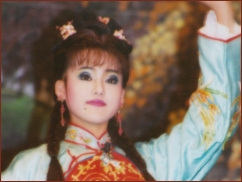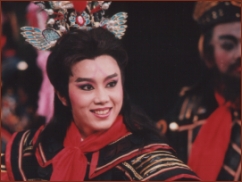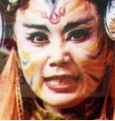|
|
 |
 Allow Females to Perform on Stage
Allow Females to Perform on Stage |
 In the past, all characters in Taiwanese Opera were played
by male troupers, including the female lead(siao dan)character.
In the 1930s, a few opera troupes began to hire females to
play siao dan. Until the period of Indoor-Stage Taiwanese
Opera, impoverished women tried to make a living by joining
opera troupes, since then, females began to act on stage.
Because female voice could naturally express the delicacy
and subtlety of different emotions, thus the “weeping tune(Kau
Diao)” was generated. Weeping tunes started to be incorporated
into scripts, love stories and romantic scenes are naturally
added into the drama. This change immediately appealed to
large legions of female viewers, because female audience strongly
felt that they could relate themselves to the plot and further,
they could empathize with the female character.
In the past, all characters in Taiwanese Opera were played
by male troupers, including the female lead(siao dan)character.
In the 1930s, a few opera troupes began to hire females to
play siao dan. Until the period of Indoor-Stage Taiwanese
Opera, impoverished women tried to make a living by joining
opera troupes, since then, females began to act on stage.
Because female voice could naturally express the delicacy
and subtlety of different emotions, thus the “weeping tune(Kau
Diao)” was generated. Weeping tunes started to be incorporated
into scripts, love stories and romantic scenes are naturally
added into the drama. This change immediately appealed to
large legions of female viewers, because female audience strongly
felt that they could relate themselves to the plot and further,
they could empathize with the female character.
|
 Female Actors Cross-casting the Male Lead(siao
sheng)
Female Actors Cross-casting the Male Lead(siao
sheng) |
 The
senior chief of the Ming Hwa Yuan, Mr. Chen Ming-ji felt the
need to emphasize the romantic atmosphere of the drama, so
he allowed females to play the female lead(siao dan). However,
most of the troupers brought their families to make a living
by roving with the troupe. If he kept using males to play
the male lead(siao sheng), then, inevitably, the male lead
would have to interact intimately with the female lead played
by females. Mr. Chen thought this might cause family dispute
among his troupe. He decided to make females cross-cast the
male lead as well. Mr. Chen’s decision was generally adopted.
In the end, almost all opera troupes used females to play
all the characters. Some troupes even named themselves “Young
Girl Opera Troupe” to attract attention. Hence, we can see
that nowadays, divas of Taiwanese Opera, such as Miss Yang
Li-hua, Miss Yeh Ching, and Miss Suen Tsuei-feng, are all
fantastic female artists that has won great popularity by
their charismatic appearance and dazzling stagecraft of the
male lead(siao sheng)character. The
senior chief of the Ming Hwa Yuan, Mr. Chen Ming-ji felt the
need to emphasize the romantic atmosphere of the drama, so
he allowed females to play the female lead(siao dan). However,
most of the troupers brought their families to make a living
by roving with the troupe. If he kept using males to play
the male lead(siao sheng), then, inevitably, the male lead
would have to interact intimately with the female lead played
by females. Mr. Chen thought this might cause family dispute
among his troupe. He decided to make females cross-cast the
male lead as well. Mr. Chen’s decision was generally adopted.
In the end, almost all opera troupes used females to play
all the characters. Some troupes even named themselves “Young
Girl Opera Troupe” to attract attention. Hence, we can see
that nowadays, divas of Taiwanese Opera, such as Miss Yang
Li-hua, Miss Yeh Ching, and Miss Suen Tsuei-feng, are all
fantastic female artists that has won great popularity by
their charismatic appearance and dazzling stagecraft of the
male lead(siao sheng)character.
|
|



